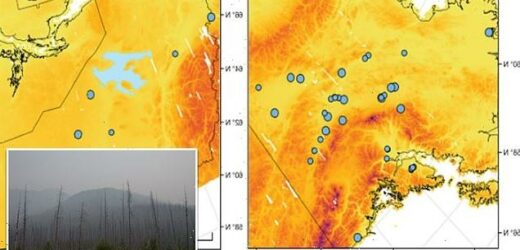Rise of the ‘zombie’ fires: Fires that smolder through winter and burst into life with devastating consequences in spring are becoming a greater threat
- Warmer summers in Alaska and Canada are causing more zombie fires
- These start in the summer, smolder through winter and reignite in spring
- Scientists determined this after mapping the fires with an algorithm from 2002
- From 2002 to 2018, zombie fires accounted for one percent of the burning
- However, it varied depending on summer temperatures each year
- For example, in 2008 a zombie fire in Alsksa account for 38% of the yearly burn
Climate change is causing a rise of ‘zombie’ fires in Alaska and Canada.
A new study published in Nature finds fires that burn in the summer, smolder through the winter and reignite in the spring are becoming more common in these regions due to warmer summers.
Scientists designed an algorithm that scanned satellite imagery from 2002 and 2018 to map the occurrence of these fires.
They found one percent of the burning in Alaska and in Canada’s Northwest Territories was caused by overwintering fires that survived from one summer to the next.
However, researchers said this varied depending on temperatures during each summer – the highest total during the study period amounted to 38 percent in 2008.
Scroll down for video
Scientists designed an algorithm that scanned satellite imagery from 2002 and 2018 to map (pictured) the occurrence of these fires. They found one percent of the burning in Alaska and in Canada’s Northwest Territories was caused by overwintering fires
‘We know that fires can start in the fire season by lightning and humans. Now we can have another cause of burned area,’ co-author Sander Veraverbeke, a landscape ecologist at Vrije Universiteit Amsterdam, told Reuters.
‘If it happens near a fire scar from the year before, early in the season, and there´s no lightning and it´s not human, then it´s an overwinter fire.’
As climate change dries out landscapes and drives increasingly ferocious summertime blazes, these zombie fires are also likely to become more common, he said.
To calculate the extent of zombie fires in the area, the researchers built a computer algorithm that considers satellite imagery, records of lightning strikes, and human presence and infrastructure.
Fires that burn in the summer, smolder throughout the winter and reignite in the spring are becoming more common in these regions due to warmer summers
For Alaska and the Northwest Territories, the algorithm produced an estimate of 0.8 percent of burned area over a nearly two-decade period.
However, a blaze that ripped through Alaska in 2008 carried on from summer into spring, and burned nearly 34,000 acres – ‘amounting to 38 percent of the annual burned area,’ researchers said.
Most fires are started by lightning striking dead, dry timber or caused by human activity, but zombie fires are a result of a warming world.
Higher temperatures prolong fire season and dry out soil that fuels these unique blazes and allows them to burn deeper into the ground – leaving massive burn scars in their wake.
And since zombie fires feed on peat soil, large amounts of carbon dioxide and methane are released into the atmosphere.
Dr. Veraverbeke told The New York Times that when fires are burning, just 10 percent of emissions come from trees while the remaining 90 percent is released from soil.
The study also found that carbon emissions from overwintering fires currently contribute 0.5 percent of the total carbon emissions from fires in Alaska and the Northwest Territories, yet ‘this fraction may grow larger with climate warming,’ the authors wrote.
Zombie fires have also been recorded in Siberia in recent years, and the new algorithm could be used with local data including satellite imagery to estimate the scope of overwintering fires in northern Russia, Veraverbeke said.
Higher temperatures prolong fire season and dry out soil that fuels these unique blazes and allows them to burn deeper into the ground – leaving massive burn scars in their wake
‘The sheer fact that this is happening is already pretty crazy and shows how fast this region is changing because of climate change,’ he said.
The findings underline the vulnerability of boreal peat, which protects permafrost below and holds huge stores of sequestered carbon, said Nancy Fresco, a landscape ecologist and climate researcher at the University of Alaska Fairbanks who was not involved in the study.
The potential for increased wildfire in the region threatens to release more greenhouse gases into the atmosphere, she said.
Source: Read Full Article





